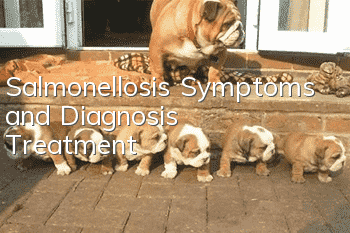Salmonellosis Symptoms and Diagnosis | Treatment

Salmonellosis is a disease common to humans and animals caused by bacteria of the genus Salmonella, and clinically manifests as enteritis and sepsis.
【Pathogen】
Salmonella is a Gram-negative bacillus with a size of 0.6~1µm×2~3µm. The main causes of disease in dogs and cats are Salmonella typhimurium (S.typhimurium), Salmonella enteritidis (S.enteritidis), Salmonella arizonae (S.arizonae) and Salmonella choleraesuis (S.choleraesuis), of which Salmonella typhimurium is the most common. Although canine salmonellosis is rare, healthy dogs can carry multiple serotypes of Salmonella. The isolation rate of Salmonella in the feces of apparently healthy dogs is 1% to 36%.
【Epidemiology】
Salmonella typhimurium is widely distributed in nature and is easily spread among animals, humans and the environment. Salmonella can survive for a long time in the external environment and can be detected from the environment. This bacterium is mainly transmitted through the digestive tract, and respiratory tract infections can occasionally occur. Recovered and clinically healthy animals can often harbor Salmonella for more than 6 weeks.
【Symptoms】
The clinical manifestations of salmonellosis include gastroenteritis, bacteremia, endotoxemia and local organ infection.
Gastroenteritis type: cases develop 3 to 5 days after infection, and are more severe in the frail, young, and elderly. It initially manifests as fever and loss of appetite, followed by vomiting, abdominal pain and severe diarrhea. When diarrhea begins, the stool is thin and watery, and then turns to mucus. In severe cases, gastrointestinal bleeding causes blood in the stool. Within a few days, obvious weight loss and severe dehydration can be seen, and the mucous membranes are pale and weak.
Bacteremia and endotoxemia types: mostly severe infections. This type is generally an early symptom of gastroenteritis, and sometimes the symptoms are not obvious, but the symptoms are more obvious in puppies and animals with low immunity. Sick animals show extreme depression, weakness, shock and central nervous system symptoms, and even death. Those with neurological symptoms show increased body stress, paralysis of hind limbs, blindness, and convulsions. Some cases may not have symptoms of gastroenteritis in the early stage.
Bacterial infection of local organs: Symptoms of pneumonia, coughing, dyspnea and nasal bleeding may occur when the bacteria invade the lungs. Miscarriage, stillbirth or weaklings occur in the womb. After bacteremia occurs, bacteria may transfer to invade other organs and cause symptoms related to the pathology of that organ.
Only a small number of sick dogs died in the acute stage, and most recovered after 3 to 4 weeks.Some continue to have chronic or intermittent diarrhea.
【Diagnosis】
1. Bacteria isolation and identification This is the most reliable method for diagnosis. In the acute phase of the disease, finding Salmonella in secretions, blood, and urine can confirm systemic infection. During autopsy, disease materials should be taken from the liver, spleen, lungs, mesenteric lymph nodes and intestines and inoculated on ordinary culture medium or MacConkey culture medium.
2. Serological tests: Use agglutination reaction and indirect hemagglutination test (IHA) to diagnose Salmonella infection.
3. The appearance of a large number of white blood cells in the feces is a characteristic of salmonella enteritis and other large-scale damage to the intestinal mucosa.
【Treatment】
1. Antibacterial and anti-inflammatory. Choose amoxicillin, chloramphenicol, amikacin, tobramycin or norfloxacin.
2. Replenish fluids and strengthen the heart. Inject 5% glucose normal saline intravenously at a dose of 40 ml/kg body weight. For patients with heart failure, 0.5% Qianerxin 1 can be injected intramuscularly; for patients with intestinal bleeding, hemostatic drugs can be injected.
3. Cleanse the intestines and stop fermentation. Apply 0.1% potassium permanganate and activated charcoal enema. Atomic oxygen produced by potassium permanganate inactivates toxins, and activated carbon adsorbs bacteria and toxins.
4. Protect intestinal mucosa. Gastric acid, bismuth subnitrate, etc. can be used orally or by deep enema.
5. Traditional Chinese medicine treatment. Pueraria lobata, Xianglian tablets, Huoxiang Zhengqi water, etc.
6. Diet therapy. When diarrhea or vomiting occurs, fasting should be carried out for 24-36 hours. After the fasting is released, prescribed food can be given a/d, i/d, or w/d.
- How to get your dog to drink more water
- Can dogs take human cold medicine when they have a cold? A guide to raising pets!
- What medicine should dogs take for diarrhea (diarrhea)?
- Why do dogs get tiny
- What should you do if your dog accidentally eats chocolate?
- Are Tibetan Mastiffs aggressive?
- Can dogs eat bananas? Why?
- Why does a dog's coat turn red?
- Is it okay to give the third dose of dog vaccine together with rabies?
- What medicine can be used to cure a puppy's skin disease quickly?



